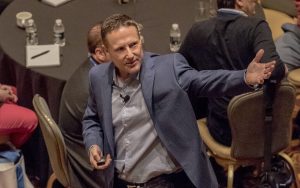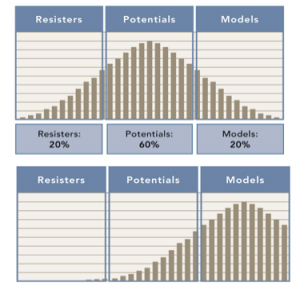 Mike has developed a unique perspective from 20+ years of working alongside a star-studded list of world-renowned thought leaders, including Dr. John Kotter, Dr. Stephen Covey, Tom Peters, Jim Kouzes, Hyrum Smith, Steve Farber and Chris McChesney. Mike served in senior leadership and consulting roles with Kotter International, FranklinCovey, and Tom Peters Company.
Mike has developed a unique perspective from 20+ years of working alongside a star-studded list of world-renowned thought leaders, including Dr. John Kotter, Dr. Stephen Covey, Tom Peters, Jim Kouzes, Hyrum Smith, Steve Farber and Chris McChesney. Mike served in senior leadership and consulting roles with Kotter International, FranklinCovey, and Tom Peters Company.
In addition to being a best-selling author, Mike is a leading authority on Unleashing Personal and Organizational Accountability, clients rely upon Mike’s solutions to; Accelerate Change, Shape Their Optimal Culture, Flawlessly Execute Key Strategies, Ignite Leadership Capacity at all Levels, Amplify Employee Engagement and Cultivate Peak Performance.
Mike consults with senior teams, facilitates custom workshops, delivers keynote speeches and provides coaching and consulting on all of these subject areas. He is experienced with executive leadership teams and groups at all organizational levels.
What does organizational culture mean to you?
Culture, simply put, is the convergence of the way your employees think and act. That culture is producing your organization’s every result (financial, operational, customer, employee, etc.). If your future desired results are loftier, more difficult, or just different than those you are achieving today, will your current culture be able to deliver? Most often, the results teams and organizations must achieve in the future will require employees to think and act differently. Creating those ‘shifts’ in how employees think and act is what will propel your team or organization toward those desired results.
Your culture is your ‘brand.’ The experiences your culture creates (the manner in which your employees think and act) will either reinforce that current ‘brand’ or evoke a new one. You can either lead your culture, or it will lead you. An organization’s (or team’s) culture is either an engine propelling it toward it’s desired results or an anchor impeding and hindering its progress. You can define, lead and shape your optimal culture.
Your organizations’ culture is the way that your employees think, the beliefs they hold and the way they act and go about their work. The results (good or bad) that your organization achieves, are a by-product of the way your employees think, act and behave. Is your culture an engine ready to propel your organization into the future, or an anchor that will impede, stifle and suffocate progress?
What are the major determinants of organizational culture?
For the most part, an organizations culture thinks, acts and behaves the way it does as a result of the experiences leadership has created or has allowed, over time. Truth be told, your organizations’ culture is a reflection of its leadership. Senior leaders must be deliberate and intentional when it comes to shaping their optimal culture. When you do not lead your culture, your culture will lead you. When your culture is not producing the desired results, leadership can proactively create shifts in the way employees think, act and behave. How? Through being intentional and deliberate in creating appropriate experiences to germinate new thinking and ultimately behavior. The process must start with identifying the specific beliefs and actions, that if held and acted upon by the majority of employees, would accelerate and propel your team or organization toward achievement of your ‘must-achieve desired results.’ Leadership must then own the process to foster and cultivate those desired beliefs and actions. The choice is yours – you can let your culture lead you, or you can define and shape your optimal culture.
Through an intentional focus on a few proven principles, you can ignite extraordinary results within your team or organization. Decades of research have pinpointed principles and practices that accelerate shifts in culture. These principles are not complicated—they don’t require an advanced degree or any specialized training. These straightforward, practical and memorable tips can transform your culture to support and deliver your ‘must-achieve desired results.’
1. Culture Shaping Cannot Be Delegated – Leaders Must Be Intentional
2. Define Your Optimal Culture – Foster Supporting Beliefs
3. Nurture Desired Behaviors and Actions
4. Leverage the Opportunity – Focus on the Middle
5. Embed the Culture into the Fabric of the Firm
What is the role of employees in organizational culture?
Watch your leaders.
What are the common problems associated with managing organizational culture?
Often a team’s or an organization’s espoused (stated) culture is incongruent with the actual culture—the culture that your customers and employees experience. The espoused culture is often what the leadership within the organization believes to be true but often is not the reality. This stated culture, and the leaders that have declared it can lose credibility with employees and customers when people see a stark difference between the ‘leader-speak’ and the reality that they experience on a day-to-day basis. The ‘brand-inside’ must be congruent with the ‘brand-outside.’ When they are not, the result is a hollow brand.
Leaders must own the process of developing and shaping an organization’s optimal culture. For many, it may feel awkward, or perhaps something that should be handed off to Human Resources. No matter how skilled your HR team may be, delegating culture change is always the death-knell to the effort. Senior leadership must possess the same degree of ownership, rigor, and passion around creating the optimal culture that it holds for developing the most important strategic initiatives that have been launched. After all, culture trumps strategy every time. As a leader, you are being thoroughly scrutinized at all times. Your employees are watching you. Every word you utter, every signal you send with your body language and the tonality of your voice, and most importantly the congruency between what you say and what you do. The quickest way to derail something as crucial as shaping your optimal culture is to behave in a manner that does not mirror the message. Leaders must be involved and highly visible throughout the process. You are being watched!
Leaders must be deliberate and highly aware of the experiences they are creating for those they lead. As those experiences will either reinforce the beliefs your employees already hold, or create new beliefs. When a leader is cognizant of this, they are more likely to create experiences that develop beliefs that will inspire the desired actions they wish to see from employees.
What are the ways to innovate company culture? Any best practices to share.
Even the best strategy is useless with an ineffective, cynical or apathetic culture. You can have the absolute best strategy, the top technical resources, and positive intent, but all of that is useless with an ineffective, unaligned, disengaged culture.
More than 20 years of data collection points to ‘communications’ as the number one vehicle for accelerating culture change and optimizing individual performance. This includes top-down communications, peer to peer, and employee to the leader. Effective communication can accelerate change, foster collaboration, ignite employee engagement, bolster morale, cultivate accountability and create shifts in behavior. Yet, often communication is not as precise, clear and consistent as needed.
Once senior leaders have defined their ideal culture, they can hasten the culture change by:
· Maintaining absolute alignment with one another and modeling the way.
· Recognize publicly, appreciate and reward employees who demonstrate desired behaviors.
· Share stories with teams, departments, and individuals about how these desired behaviors have produced positive results (stories shift beliefs).
· Consistently, in all communications, cite the desired behaviors and link them to success stories or the impact they are having on results.
· Frequently offer appreciative feedback to those living out the desired behaviors. When individuals receive the appreciative feedback they will demonstrate those behaviors more frequently. This also calls attention to and creates alignment, around the desired behaviors that will propel the organization toward what matters most.
· Integrate desired behaviors and beliefs into performance management systems and rewards and recognition systems.
No matter the strategy or initiative, no matter how critical or mundane, there will always be employees that fall into one of three categories:
· Resisters (Will never jump on board. Either they can’t or they won’t)
· Potentials (Too busy with the day-to-day work to help. Caught up in the minutiae of the day to day tsunami of work)
· Models (Will walk on broken glass for you)
One of the keys to accelerating culture change is to move as many ‘potentials’ (see graphic to right) further to the right into the ‘model’ category. The real opportunity is with the potentials. The resisters often never come along or jump on board. In fact, that is the group the often heavily recruits the ‘potentials’ to join them. When leadership can move the ‘bell’ righter and tighter, achievement of desired results accelerates.
A major mistake is to focus on the ‘resisters’ in hopes of getting them onboard. Forget about them. Do not waste a brain cell on them. For the most part, they will never change. The key is to leverage your models and your potentials.
GAINING BUY-IN AND COMMITMENT
Simply telling people to change and embrace and adopt new ways of thinking, to hold new beliefs, and in some cases to change the habit, without engaging them in the process yields poor results. It is human nature to resist change.
Most individuals externalize the need for change. They believe everyone else must change and that I am doing quite well. So as a leader you must focus your attention on those who are ‘on the fence.’ This is the group that will provide you with the most leverage. As you engage more of those ‘in the middle,’ others will join the cause or self-select out. Don’t waste time or resources worrying about the ‘resisters.’ They will never help your organization achieve anything of significance.
When employees in the ‘potential’ category self-select to move into the ‘model’ category, organizations realize the exponential impact on the ability to realize their ‘must-achieve desired results.’
Create a culture focused on achieving desired results
Sounds great, right? Yet, so often employees within many organizations focus on ‘daily activity’ and not the highest priority organizational desired results. There is a major difference between ‘activity’ and ‘results’. Activity in and of itself will not necessarily produce desired results. Answer this – does all activity produce results? Trick question. Many quickly answer with a strong, “no.” The answer is yes. Even if you do nothing you will achieve a result. It simply may not be the result you want. When we develop a culture that views their ‘job’ as ‘achieving desired results’, organizations realize:
· Heightened levels of collaboration and teamwork
· Increased levels of trust and candor
· An elevated focus on the key constituents
· An escalation in personal and organizational accountability
· A ‘solutions’ focus versus playing the blame-game
· A mindset of “what else can I do’ versus ‘it’s not my job’
· Soaring levels of employee engagement
Shaping and creating your optimal culture starts with:
1) The senior leadership team creating clarity on the top two to five most important results (goals) that the organization must achieve in the next 12-24 months. These ‘must-achieve desired results’ must meet three criteria: meaningful, measurable, and memorable.
2) Once the desired results are agreed upon, the senior leadership team must be 100% aligned and all members accept ownership and accountability to communicate the key messages to the organization.
3) The third step is to define what the optimal culture would look like in order to achieve these desired results. How would you see people behave? What beliefs would they hold? What would they be doing differently? What are the key gaps in behaviors and beliefs that are impeding progress toward the desired optimal culture? What behaviors do we want to maintain and embrace? What behaviors must be abandoned?
4) Leaders at all levels then must apply proven, pragmatic tools, principles, and methodologies to create shifts in the way that employees think, act and behave in order to support and ultimately realize the defined optimal culture. Leadership must then create the appropriate experiences that will heighten focus on desired beliefs and actions, and provide the impetus for employees to voluntarily choose to change their behaviors.
The process takes discipline and focus. But the payoff is huge.
Order from Amazon– https://www.amazon.com/dp/1119314089
Watch Mike Interact with His Clients – https://vimeo.com/230374774
Contact Details:
Mike Evans
QuestMark
(412) 334-8672
mobile (877) 833-1216 ext. 917
LINK TO E-SPEAKERS PROFILE: https://www.espeakers.com/marketplace/v3/profile/31791/mike-evans


